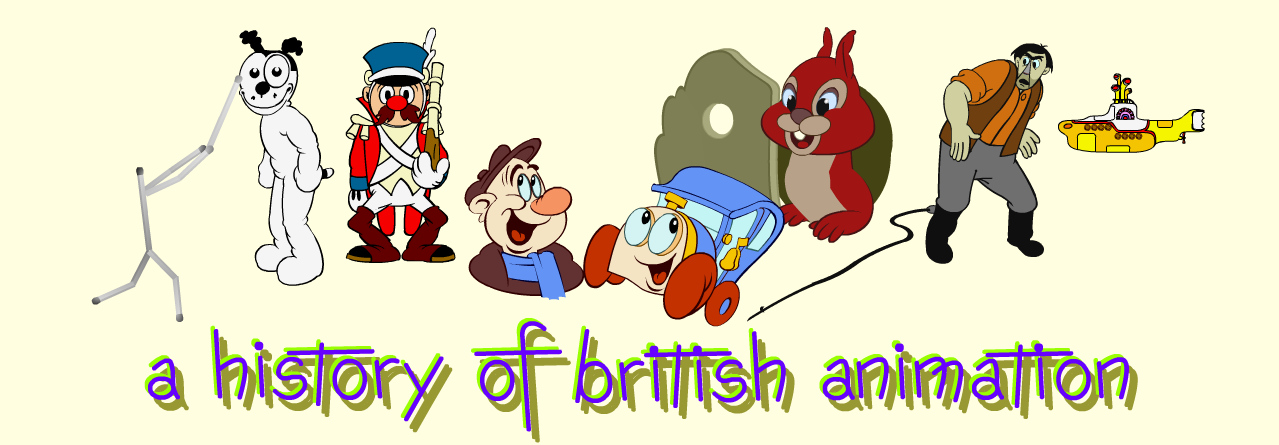

|
 | ANSON DYER STUDIOS LTD(1939-1958) |  |
||
|
Veteran animator Anson Dyer had been set up in a studio in Jermyn Street by wealthy producer Archibald Nettlefold to produce colour cartoon entertainment shorts. They made several films, including a series featuring the stubborn soldier Sam Small, hero of a succession of comic monologues narrated by Stanley Holloway. Although quite popular, these films did not return enough money, and the company, Anglia Films, began to run up debts, so the studio concentrated to the more reliable profits of advertising films. Nettlefold withdrew from the company, and Dyer set up two new ones, Anglia Films (Continental) Ltd and Anson Dyer Productions Ltd to take over the debt burdon from Anglia Films. In April 1938 these new companies went into liquidation. Riverside StudiosThree months later Kinematograph Weekly announced, on its British Studio News page: Anson Dyer Resumes Production Dyer retained his staff and equipment and continued to operate as Anglia Films, setting up in a suite of offices at the Riverside Studios, Hammersmith, a small film studio with two sound stages that had been acquired by the live-action producer Julius Hagen, as an overflow from his Twickenham Studios, for shooting 'quota quickies'. Hagen's companies had been forced into liquidation, and control of the Hammersmith studio had been granted by the liquidator to one of Hagen's film directors, Leslie Hiscott, so that it could continue to be used by other production companies. Dyer's studio formed a self-contained unit, but he had the advantage of access to film vaults, editing facilities and, most importantly, a large dubbing theatre. In August 1938 actor Jack Buchanan took over the lease for his own production company, with Dyer's studio remaining as a sitting tennant. Dyer's first concern was to register a new company, Anson Dyer Studios Ltd, although he continued to use Anglia Films as well. The animators Jørgen Myller and Henning Dahl Mikkelsen, who had been responsible for the Sam Small cartoons, had now returned to Denmark. Dyer's staff now included Laurie Price, previously the head animator at Publicity Pictures, American animator Ed Smith, who had been an assistant animator at Walt Disney's studio, Len Kirley, who had joined Dyer as an animator in 1937, Bob Privett, who had started as an assistant to the Danes in 1935, Gerald Grubb and Kathleen "Spud" Murphy, who had worked as a tracer and painter on London Film Productions' Technicolor cartoon short The Fox Hunt (1936), designed and animated the diagrams in How the Motor Works (1938) for British Animated Films and now started as both a tracer and an inbetweener for Dyer. Another of the tracers was Connie Pope, who had joined Dyer's studio in 1935. Productions were directed by animator and inventor Sid Griffiths, who now concentrated on organising recording sessions, breaking down dialogue sound tracks and generally running the studio. The cameraman was Charles Stobbart. Both men had joined Dyer in 1935. I have not found any references to the Continental commercials made, but the series of Bush Radio advertisements Dyer had been making for Publicity Films continued with This Button Business, narrated by comedian Vic Oliver, which examined the importance of buttons to firemen, nudists and Cockney pearly kings, and ended up with the new pre-tuned push-button radios from Bush. Ed Smith was also ready to return home. His last film for Dyer was probably Red, White and Blue, an advertisement for Samuel Hanson & Son's French coffee essence which the Advertiser's Weekly (29 September 1938) described as follows: It tells the story of three Foreign Legionnaires Beau Best, Beau West and Beau Zest, who are sent into the desert by a villainous sergeant, Beau Looney. Red, White and Blue coffee essence plays a stirring part in the eventual rescue. Red, white and blue are the predominant colours of the film, and the tune "Three Cheers for the Red, White and Blue" is also featured. Ed Smith returned to the States in September 1938, sailing from Southampton on the 21th. The studio continued to concentrate on advertising films, and it would seem they made at least one stop-frame model film. At the beginning of 1939 the Kinematograph Weekly ran this item: A NEW TYPE OF CARTOON For an article promoting a 'novel apparatus' this is remarkably uninformative. My best interpretation is that it was a mechanism for smoothly moving a table-top (model animation) animation camera frame-by-frame to track in and out while maintaining focus and exposure. Dancing cigarettes suggest model animation rather than cel animation, and there is no mention of cels so it is presumably not like the Fleischers' 'set-back' camera, where cels were shot vertically in front of a model background on a turntable. The reporter does not really seem to understand what it is that he is supposed to be extolling. Perhaps Griffiths concentrated on the details and failed to paint the bigger picture. If they were hoping to move into model work they were facing stiff competition – in 1933 Hungarian animator George Pal had been set up in a former butcher's shop in the Dutch town of Eindhoven to make animated commercials for radio and electrical manufacturers Philips, using his Pal-Doll technique of wooden models with replaceable parts, which allowed sequences of stretch and squash to be used in the action. Pal was contracted to make films for Philips alone, but in 1936 Gerard Holdsworth, a representative of the London branch of advertising agency J Walter Thompson, negotiated an arrangement for Pal to make a series of advertising films for Horlicks, for the British market. The tobacco company W D & H O Wills sponsored a short documentary, You're Telling Me (1939), directed by A G Jackson for Gaumont-British Screen Services, showing the Anson Dyer Studio working on a coventional cel-animation advertising film for their Capstan cigarettes, with the finished commercial rounding off the presentation. This must have been a short, 50-second film as the entire documentary is only 5½ minutes long. The documentary shows Anson Dyer, Sid Griffiths and Kathleen Murphy at work, and was shot in Technicolor. Although probably shot at Riverside Studios, it did not feature Dyer's actual studio. The high level of lighting required for live-action Technicolor meant that the studio had to be "recreated" on the sound stage: the result was a surreally tasteful concotion where tracers and painters in matching purple smocks work at pristine white desks beneath the slope of a row of smart, sparkling clean skylight windows. On 1 June 1939 the Kinematograph Weekly reported Anson Dyer's plans for a new series of cartoon films in Technicolor with Peter Panda as the central figure. Pandas were big news in 1938-39. New York Zoo had acquired a young panda which arrived in San Francisco from China in June 1838, an event that inspired the Walter Lantz character Andy Panda, and when in December London Zoo got its first pandas, the popularity of the cute baby Ming clearly prompted a similar reponse at Anson Dyer's studio. I do not know how far the pre-production work for this series may have got, but the outbreak of War brought any plans for entertaiment films to an end. Dyer had started his career in animation making propaganda cartoons mocking the Kaiser during the First World War, and the studio's response to the outbreak of World War Two was initially in the same vein, making four short animated spots ridiculing Hitler for inclusion in the Gaumont-British Newsreels. But with the occupation of France and the imminent threat of invasion the situation became too serious for such simple levity. The Ministry of Information commissioned animated films to advertise and encourage practices on the home front to aid the war effort, and the armed forces needed diagrams for training films. Dyer's studio was commissioned to make a series of aircraft recognition films for the RAF. Besides conscription, Dyer lost staff to other projects: the forces had started preparing for conflict back in 1936 and by 1939 Connie Pope's tracing skills were already being employed by the Admiralty, and it appears that Gerald Grubb was drawing maps for the Air Ministry. When a young illustrator and cartoon enthusiast called Harold Whitaker applied for a job in the summer of 1940, he was hired as a background artist. When German bombers began to blitz London in September 1940, using the River Thames for navigation, Dyer decided that the Hammersmith studio was at risk, and prepared to relocate the studio out of London. Stratford AbbeyStratford Abbey, in Stroud, Gloucestershire, was a 17th-century building remodelled in Tudor style in the 19th century (it retained a chimneypiece dated 1699) as a home for John Biddell, owner of flour-producing Stratford Abbey Mill. In 1869, his son, Sidney Biddell, sold the house to Miss Rosa Stella Isacke, the headmistress of a school at Roxborough House, Nelson Street, Stroud. She moved the school to Stratford Abbey and renamed it Stratford Abbey College. She and her younger sister Ada ran the school until 1973, when Ada married and resigned to raise a family. Rosa continued to run the school as headmistress, assisted by six masters and five resident governesses. In 1907 her neices, stella Kitty and Muriel, took over the running of the school and continued for a further twenty years. In 1939 the school closed down and Kitty sold Stratford Abbey to R Townsend & Co Ltd, the owners of Stratford Mills, which may have held the original freehold. It was to this property that Dyer evacuated his studio and staff. Rinso Advertising FilmsSome commercial films were made despite the War and the shortage of products on the shelf. In 1939 J Walter Thompson had contracted with Pal in the Netherlands to make a series of cel-based cartoons advertising the soap powder Rinso, the soundtracks for which were recorded by the agency in London. Pal and his wife were visiting the United States when war was declared, and decided not to return, but the studio carried on working, and two or three of these films were completed. However, with the German occupation of the Netherlands in May 1940, it became impossible to continue. According to the BFI Pal's studio made The Queen Was in the Parlour (1939), The Old Woman Who Lived in a Shoe (1940) and The Good Bear and the Bad Bear (1940), but subsequently the series was handled by the Dyer studio. Their principal work was the production of Government-sponsored Public Information films and training films (they made . As an inactive company Anson Dyer Studios was struck off the register at Companies House in 1958. studio person
SORRY, THIS PAGE IS STILL UNDER CONSTRUCTION. |
Filmography | ||||
| Title | Date | |||
|---|---|---|---|---|
| Producer: | Name | |||
| Director: | Name | |||
| Animator: | Name | |||
| Camera: | Name | |||
| Colour: | ||||
| Sound: | ||||
| Length: | approx. 300 ft (3.4 mins) | |||
| Title | Date | |||
| Producer: | Name | |||
| Director: | Name | |||
| Animator: | Name | |||
| Camera: | Name | |||
| Colour: | ||||
| Sound: | ||||
| Length: | approx. 300 ft (3.4 mins) | |||
| Title | Date | |||
| Producer: | Name | |||
| Director: | Name | |||
| Animator: | Name | |||
| Camera: | Name | |||
| Colour: | ||||
| Sound: | ||||
| Length: | approx. 300 ft (3.4 mins) | |||
| Title | Date | |||
| Producer: | Name | |||
| Director: | Name | |||
| Animator: | Name | |||
| Camera: | Name | |||
| Colour: | ||||
| Sound: | ||||
| Length: | approx. 300 ft (3.4 mins) | |||
Links to Other Sites | ||||
|
Website Title Description. Website Title Description. Website Title Description. |
Peter Hale
Last updated 2022
|